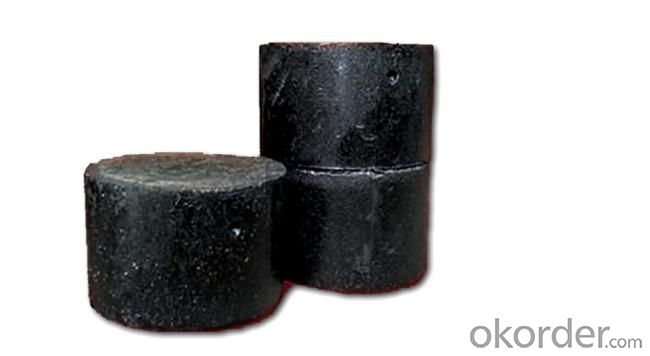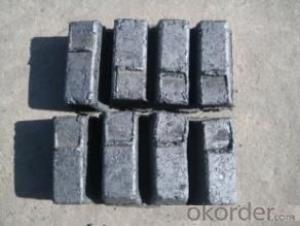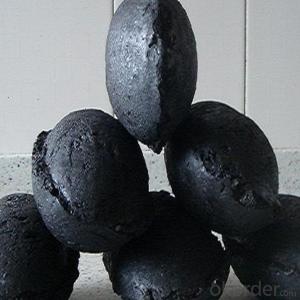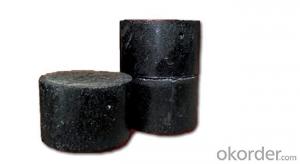cylinder Carbon Electrode Paste with DIA 500-600mm
- Loading Port:
- Lianyungang
- Payment Terms:
- TT OR LC
- Min Order Qty:
- 20 m.t.
- Supply Capability:
- 20 m.t./month
OKorder Service Pledge
OKorder Financial Service
You Might Also Like
Spcifications
1:carbon eletrode paste
2:for ferroalloy,calcium carbide manufacture
3:HS 3801300000,YB/T5212-1996,ISO9001:2008
Product Description
Carbon Electrode Paste is a self-baking electrode used in submerged arc furnaces for delivering power to the charge mix. Electrode Paste is added to the top of the electrode column in either cylindrical or briquette form. As the paste moves down the electrode column the temperature increase causes the paste to melt and subsequently bake forming a block of electrically conductive carbon. Electrode Paste is essentially a mix of Electrically Calcined Anthracite (ECA) or Calcined Petroleum Coke (CPC) with Coal Tar Pitch.
Graphite/Carbon Electrode Paste Specification:
| PARAMETER UNIT GUARANTEE VALUE | ||||||
| Ash.( % ) | 4.0 max | 5.0 max | 6.0 max | 7.0 max | 9.0 max | 11.0 max |
| V.M (%) | 12.0-15.5 | 12.0-15.5 | 12.0-15.5 | 9.5-13.5 | 11.5-15.5 | 11.5-15.5 |
| Compress Strength. | 18.0 min | 17.0 min | 15.7 min | 19.6 min | 19.6 min | 19.6 min |
| Specific Resistance | 65 max | 68 max | 75 max | 80 max | 90 max | 90 max |
| Bulk Density | 1.38 min | 1.38 min | 1.38 min | 1.38 min | 1.38 min | 1.38 min |
Picture:
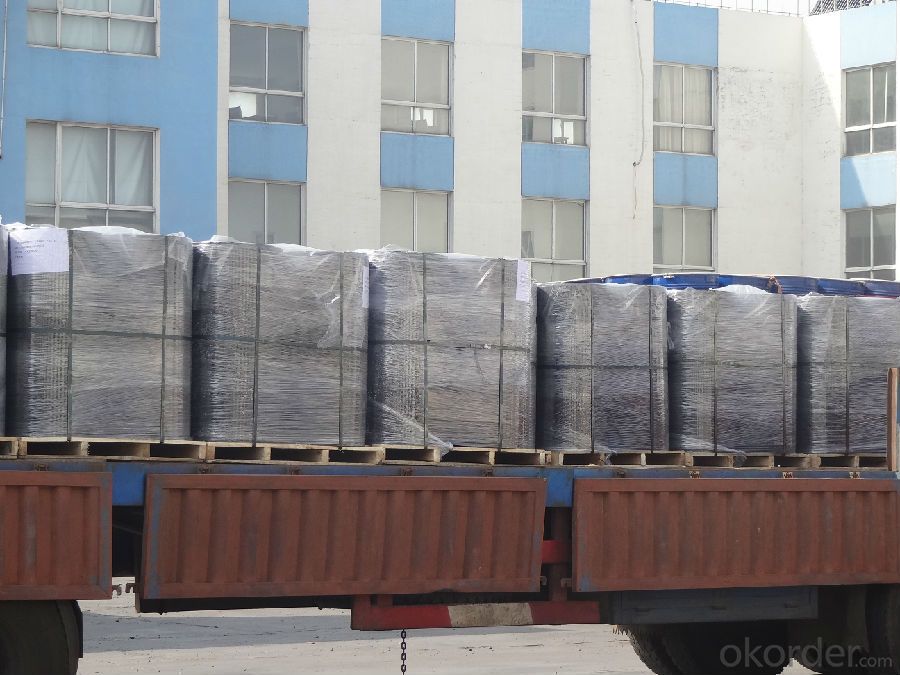
- Q: I don't know the battery. Although I know the former is chemical energy, I want to know if the 1 grain size 5 can compare the charge capacity with the 1 grain 5 1ANot much of a fortune, but thank you very much for the enthusiastic friend who gave me the answer. Thank you!
- The typical capacity of a AA carbon cell is 500maH, the voltage is 1.4V (average discharge platform) and the power is 0.7WHA typical capacity of AA alkaline battery is 2800maH, the voltage is 1.4V (average discharge platform) and the power is 3.9WHA AA disposable lithium iron battery, the typical capacity is 3000maH, voltage is 1.5V (discharge platform average), power is: 4.5WHA AA nickel hydrogen rechargeable battery, the maximum capacity is 2700maH, voltage is 1.2V (average discharge platform), power is: 3.2WHA AA lithium rechargeable battery, the maximum capacity is 800maH, the voltage is 3.7V (average discharge platform), power is: 2.9WHA AA lithium iron phosphate battery has a maximum capacity of 700maH, a voltage of 3.2V, and a power of 2.2WhBased on the above data, it is concluded that AA single iron lithium battery and disposable alkaline battery are the most durable, and their capacity (no matter size, current, discharge) is more than 6 times of that of carbon battery
- Q: What are the different allotropes of carbon?
- Carbon has several allotropes, each possessing unique physical and chemical properties. The most renowned allotrope is diamond, renowned for its hardness and brilliance. Diamond consists of carbon atoms arranged in a three-dimensional structure, with each atom bonded to four neighboring carbon atoms in a tetrahedral pattern. Graphite is another carbon allotrope, known for its softness and ability to conduct electricity. Carbon atoms in graphite are arranged in layers that are held together by weak forces, allowing easy sliding between layers. This layered arrangement grants graphite its lubricating properties. Fullerenes, a distinct class of carbon allotropes, are composed of carbon atoms arranged in closed cage-like structures. The most famous fullerene is buckminsterfullerene (C60), made up of 60 carbon atoms bonded together to form a hollow sphere resembling a soccer ball. Fullerenes exhibit unique properties such as high tensile strength and superconductivity. Carbon nanotubes, cylindrical structures made from rolled-up graphene sheets, are yet another carbon allotrope. The arrangement of carbon atoms determines the structure and properties of carbon nanotubes. They are recognized for their exceptional strength, electrical conductivity, and thermal conductivity. Amorphous carbon, lacking a definite crystal structure, is another carbon allotrope. It is commonly found in substances like soot, coal, and charcoal. Amorphous carbon can possess a wide range of properties based on its structure, varying from soft and powdery to hard and brittle. These examples highlight the diverse allotropes of carbon. Carbon's ability to form various allotropes with distinct properties contributes to its significance in numerous applications, including jewelry, electronics, and material science.
- Q: How about Zonta carbon technology
- The factory garbage to death, wages do not rise, but down, quarterly awards fell by more than half, production targets set very high, employees can not reach the goal, not to work overtime. This is a company's way of restricting employees to work overtime. And so on, the target production has been added, so never meet the requirements, overtime do not think. A large piece of employee turnover now
- Q: What are greenhouse gases?
- Greenhouse gases are gases that trap heat in the Earth's atmosphere, contributing to the greenhouse effect and causing global warming. Some examples of greenhouse gases include carbon dioxide, methane, and nitrous oxide.
- Q: Why is the longer the carbon chain, the better the hydrophobic properties?
- The carbon chain is the water chain, but the lower the polarity (TA)They have to write fifteen characters ah from702853 (station link TA) can theoretically explain it zhoupeng87 (station link TA) should be the basic alkyl is not hydrophilic, it belongs to the hydrophobic group, the increase of carbon chain length of the hydrophobic whyy0113 (station TA) carbon chain is longer, the more polar groups easily entrapped nature shows hydrophobic alkane name small Jia (TA station) the carbon chain length of hydrophobic chain length, of course, hydrophobic. Cher (station TA) the alkyl chain is hydrophobic, so the longer hydrophobic part content more hydrophobic natural good red sandalwood fragrance (TA station).
- Q: What is the carbon footprint?
- The carbon footprint is a measure of the total greenhouse gases, specifically carbon dioxide (CO2), that are released into the atmosphere due to human activities. It quantifies the impact individuals, organizations, or countries have on the environment by contributing to climate change. This impact encompasses both direct emissions from burning fossil fuels for transportation, heating, and electricity, as well as indirect emissions from the production and transportation of goods and services we consume. Measured in units of carbon dioxide equivalent (CO2e), the carbon footprint serves as a vital tool for assessing and managing our environmental influence. By comprehending and diminishing our carbon footprint, we can alleviate climate change and strive for a more sustainable future.
- Q: What are the properties of carbon-based adhesives?
- Carbon-based adhesives have a range of properties that make them highly versatile and effective. Firstly, they have excellent adhesion capabilities, allowing them to bond to a wide variety of surfaces. Additionally, they exhibit high strength and durability, ensuring long-lasting and reliable adhesive connections. Carbon-based adhesives are also known for their resistance to heat, chemicals, and moisture, making them suitable for various applications in different environments. Furthermore, they can be easily applied and cured, allowing for efficient and quick assembly processes. Overall, the properties of carbon-based adhesives make them a popular choice for industries such as automotive, aerospace, electronics, and construction.
- Q: Can carbon 14 identify the age of porcelain?
- Identification of porcelain by carbon 14 is not very accurate.The so-called carbon fourteen assay, radiocarbon dating, uses the carbon fourteen, which is widely found in nature, to measure the age of animals and plants. In prehistoric and ancient, the smaller the impact of human activities on the earth's environment, and carbon in nature fourteen proportions remain constant, animals and plants in the survival time, due to its in vivo The new supersedes the old. sake, carbon fourteen also remained constant; however, the once dead, in fourteen carbon will continue to decay, the half-life is 5730 years, in the sealed state and the outside world is obviously different, which is the principle of carbon fourteen dating. We must note that animals and plants belong to the organic matter. However, most cultural relics, such as porcelain, pottery and bronze, are inorganic. Therefore, the application of carbon fourteen dating in archaeology is very limited.
- Q: How can carbon capture and storage help reduce greenhouse gas emissions?
- Carbon capture and storage (CCS) is a technology that can play a significant role in reducing greenhouse gas emissions. It involves capturing carbon dioxide (CO2) produced from industrial processes or power generation, transporting it, and then storing it underground in geological formations. Firstly, CCS can help reduce greenhouse gas emissions by capturing CO2 directly from large point sources, such as power plants or industrial facilities, that would otherwise be released into the atmosphere. By capturing and storing this CO2, it prevents it from contributing to the greenhouse effect and mitigates its impact on climate change. Secondly, CCS can enable the continued use of fossil fuels, such as coal or natural gas, in a more environmentally friendly manner. These fuels are currently the primary sources of energy for electricity generation and industrial processes. By implementing CCS, the CO2 emissions from these fossil fuel-based activities can be drastically reduced, allowing for a transition towards cleaner energy sources in a more gradual and economically feasible manner. Furthermore, CCS can also be coupled with bioenergy production, creating what is known as bioenergy with carbon capture and storage (BECCS). This process involves using biomass, such as crop residues or purpose-grown energy crops, to produce energy. The CO2 emitted during the bioenergy production is then captured and stored, resulting in a negative emissions process. BECCS can effectively remove CO2 from the atmosphere, helping to offset emissions from other sectors and achieving net-negative emissions. Lastly, CCS can contribute to the decarbonization of hard-to-abate sectors, such as cement and steel production, where alternative low-carbon technologies are currently limited. By capturing and storing CO2 emissions from these sectors, CCS can significantly reduce their overall greenhouse gas emissions and facilitate their transition towards more sustainable practices. In conclusion, carbon capture and storage technology can help reduce greenhouse gas emissions by directly capturing and storing CO2 from large point sources, allowing for the continued use of fossil fuels in a more sustainable manner, enabling the deployment of negative emissions technologies like BECCS, and supporting the decarbonization of hard-to-abate sectors. Implementing CCS alongside other mitigation strategies can play a vital role in achieving global climate goals and combating climate change.
- Q: How does carbon dioxide affect the formation of clouds?
- Carbon dioxide does not directly affect the formation of clouds. However, it is a greenhouse gas that contributes to global warming, leading to changes in atmospheric temperature and humidity, which can indirectly impact cloud formation and properties.
Send your message to us
cylinder Carbon Electrode Paste with DIA 500-600mm
- Loading Port:
- Lianyungang
- Payment Terms:
- TT OR LC
- Min Order Qty:
- 20 m.t.
- Supply Capability:
- 20 m.t./month
OKorder Service Pledge
OKorder Financial Service
Similar products
Hot products
Hot Searches
Related keywords


